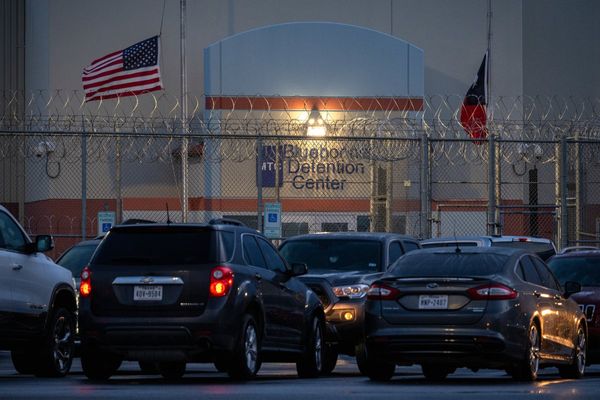
On the grounds of Williamsport High School in western Maryland, three 17-year-olds pile into the cab of a white Volvo truck, pens and pads in hand.
They record the odometer, check for warning lights, honk the horn and test the brakes. It's all part of what's called a pre-trip inspection.
In the real world, the process takes about 10 minutes, but today the students move slowly and methodically, under the watchful eye of their instructor Eric Young.
"This is a $100,000 truck," Young says. "If you blow the engine because of negligence, you're going to be looking for a new job."
This fall, for the first time, this introduction to trucking course is being offered at Williamsport High School as part of a nationwide push to steer young drivers toward an industry in dire need of workers.

Over the next decade, trucking industry says it will need to hire more than a million drivers
The American Trucking Association projects that trucking companies will need to hire nearly 1.2 million drivers over the next decade.
Part of that's because of a rapidly aging workforce: the average age of long-haul truck drivers is 46, according to the group. And when lifting heavy pallets of goods comes as part of the job, the pool of drivers becomes even smaller.
Another reason is lifestyle. Many long-haul truckers say wages aren't high enough to make up for endless days on the road away from their families. Turnover in the industry is high.
One idea that's gaining traction: Getting young drivers into the industry earlier.
Traditionally, trucking has not been among the vocational programs offered at high schools, in part because of age restrictions on interstate trucking. Federal law requires drivers of commercial vehicles to be at least 21 years old to cross state lines.
"That's where you make most of your money at," says Joshua Hewitt, a 17-year-old senior at Williamsport High School who's enrolled in the trucking class. "You can make money in state, but over state, going from West Coast to East Coast — that's where you make the most money."


But now, the federal government is piloting a three-year apprentice program that will allow 18-to-20-year-olds to drive commercial vehicles on interstate routes, opening up career opportunities for high school graduates that didn't exist before.
A growing number of high schools are looking to seize on that opportunity. At Williamsport High, the goal is to prepare students to sit for their commercial driver license permit tests when they turn 18. After that, they have one road skills course to take at the nearby community college before they can obtain their commercial licenses.
"By August, they could be drawing a six-figure salary," says Young.
A teen's disinterest in school drove the creation of the trucking program
The idea for the trucking course at Williamsport High School originated with assistant principal Adam Parry.
A couple of years ago, Parry was talking with a group of sophomores, including Tucker Bubacz, a personable farm kid who'd grown up around trucks and tractors.
"He wasn't doing well academically. So when that happens, you sit down and you have that discussion to figure out what's going on," says Parry.

The assistant principal saw an enthusiasm gap. Bubacz and his friends weren't motivated by school. They also weren't particularly excited about the vocational programs on offer, including construction and hospitality. But he had a hunch that trucking might be different.
Williamsport sits along two major interstates, just minutes away from West Virginia and Pennsylvania. A trucker friend had told Parry of the tremendous demand for drivers.
"From his viewpoint, there was going to be fifty-some thousand jobs just in this area alone in the next five to 10 years," says Parry.
So he ran the idea of a trucking class past Bubacz.
"Yeah, I want to drive a truck!" was the teenager's emphatic response. He's now one of three students enrolled in the inaugural class.
Teenagers are not yet driving interstate routes
The Department of Transportation's Safe Driver Apprenticeship Pilot Program was approved by Congress in 2021 as part of the bipartisan infrastructure law. The program seeks to enroll several thousand apprentices over three years.
So far, it's off to a slow start.


To date, half a dozen trucking companies have been approved for the program.
Those companies must first enroll experienced drivers who will supervise the apprentices, before they can bring on the apprentice drivers themselves.
At DOT Foods, one of the participating companies, transportation director Dave Hess says he has no qualms about putting 18-to-20-year-olds on interstate routes provided they demonstrate they're capable.
"We're not going to put anybody on the road who can't handle the equipment and be safe," says Hess. "You got immature 45-year-old people. So it's really on the person, their skills, their understanding of the [Department of Transportation] laws."
When the apprenticeship program was first proposed, safety advocates. including the National Transportation Safety Board were quick to raise red flags. Teenage drivers can be easily distracted. They have higher crash rates. Research has found young drivers are more likely to underestimate dangers.
The perils of the road is a topic of frequent discussion at Williamsport High.
"It's very dangerous going downhill sometimes," says Hewitt. "Your 80,000 pound vehicle — that could kill anybody."

Bubacz, who learned to drive a tractor as a young kid, is nervous about other drivers.
"You can be the best driver there is, but there's always some bad driver that could mess something up," he says.
A younger workforce may be well-suited for the industry
There are some upsides to having younger people behind the wheel.
Recent high school graduates typically have fewer family responsibilities. Their bodies have yet to endure the wear-and-tear of working life.
They could bring fresh energy to an aging workforce.
While Bubacz thinks he'll opt for day trucking, Hewitt imagines a life for himself on the road.
"You can sleep wherever inside of your truck, as long as you're at a truck stop, or somewhere on the side of the road — whatever you want to look at at night," he says.

Their classmate Peter Vilas Novas sees trucking as a way to see the country.
"Just traveling and getting to see places while doing your job and making money," he says.
High on his list — California.







